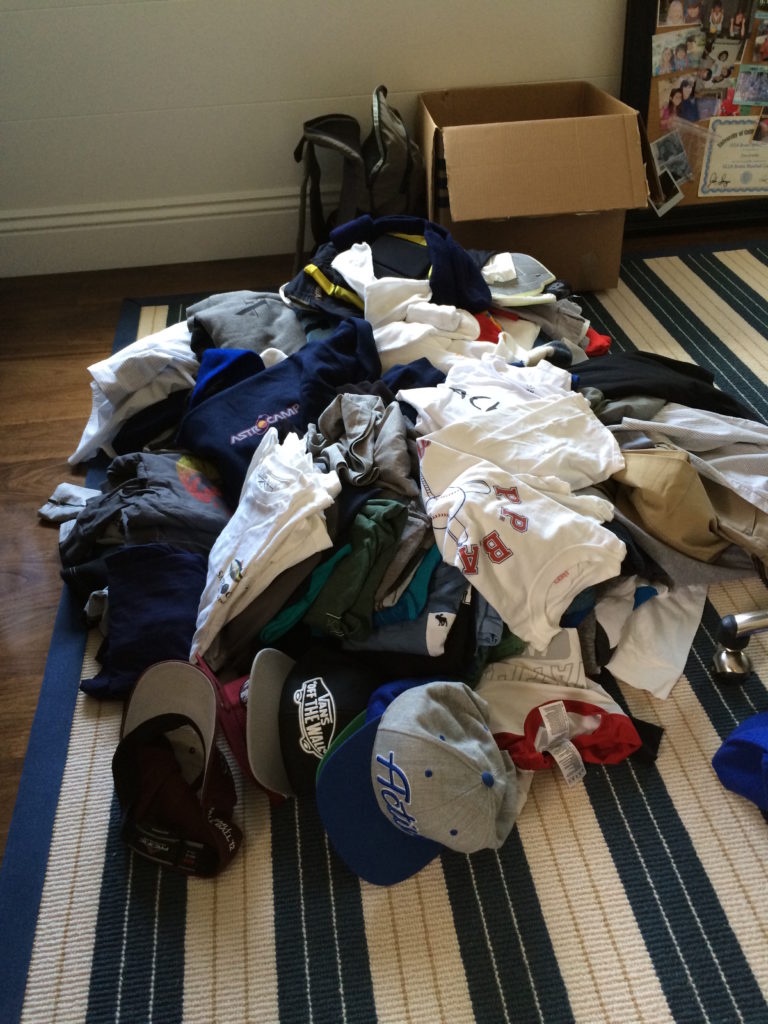Anyone who’s stood in front of a tower of dirty dishes, mountain of laundry, overstuffed cabinet, or a near-to-bursting closet knows how frustrating and overwhelming clutter can be. The following guest post from expert organizer Tracy McCubbin of dClutterfly offers practical solutions for anyone drowning in stuff.
It’s the most wonderful time of the year — time to send the kids back to school and reclaim your household! After a summer of camps and goofing around inside, your house may need a little tough love to get back into shape. Research shows that the average American home has 300,000 items in it, and back-to-school is the perfect time to get rid of the ones that aren’t needed anymore.
Here are 10 of my favorite tips to declutter your home this fall:
1. Don’t let papers pile up:
Pull out all the homework and artwork from the previous school year. Before the onslaught of this school year’s new stuff, make sure you have decluttered last year’s. Homework has one purpose and one purpose only: to help kids learn. It’s not to be immortalized in boxes in the garage that you’ll never look it. Empty backpacks, desk drawers and those piles you’ve been meaning to tackle and pick the best of the best. Save the things that are substantial and remind you who they were at the time in their lives. As for artwork, how many turkey hands does one family need? Pare down to a small but great representation of their masterpieces and let the rest go. Take photos if you just can’t bare to let them go. You might want to also consider making art books out of the artwork.
2. Sort through the bookshelf:
Did summer reading lists create a glut of books in your home? Time to do a purge of the books that won’t get read again or won’t ever be read, period. Of course there are classics and favorites that will be kept forever, but ask your kids if they really are going to read something for the 4th time. Anything not needed can be donated. Most libraries are facing deep budget cuts and lots of them have turned to book sales to keep their doors open a little later and on weekends. Check with your local library to see if they are accepting books and while you are there, return those overdue library books.
3. Donate (or toss if they are broken) toys:
After a summer of “I’m bored,” you’ll have a great idea of what toys your kids really play with. And don’t forget the holidays (AKA more stuff) are just around the corner. 3.1% of the world’s children live in America, but they own 40% of the toys consumed globally. If letting go of toys is difficult for your kid, try the halfway approach. Sort the toys into four piles: keep, donate, trash and not quite yet. Box up the “not quite yet toys” and put in a closet or garage. Tell your kids if they really miss the toy and want to play with it, it’s right there. But chances are, out of sight, out of mind…
4. Evaluate clothing:
Little ones seem to sprout up like weeds, leaving a lot of outgrown clothes. Time to do a deep dive on their clothes and donate what they don’t wear or can’t fit into any more. This is a great process to involve kids in as it gets them used to the idea of letting go. First, do a pass when they are at school and make a pile of the clothes you think are too small or worn out. Then when they are home, ask them what they are okay letting go of. Have them try it on to make sure it really fits. If there are younger siblings or cousins, put them into the hand-me-down box. Also, consider doing a clothes swap with other families.
5. Donate old backpacks:
Most kids get new backpacks for each school year. If last year’s pack is still in good shape, think about donating to a local nonprofit that works with foster kids. Use this as an opportunity to declutter backpacks, duffle bags and suitcases. Foster kids are in dire need of suitcases, duffle bags and backpacks. Because they are moving around so much and don’t have a permanent home, they often move to multiples times with their belongings in a trash bag. Finding a local organization that provides these donations to local foster kids is a great way to teach your kids about giving back.
6. Donate old sports equipment:
Has the team gotten a new logo making the old uniforms out-of-date? A client called me up to say that her daughter’s school team did and they had so many uniforms that were still in great shape but useless to them. I happened to be going to Kenya at that time to work with girls there, so I volunteered to bring the uniforms to Nyamasare Girl’s School and Orphanage for their football team. They were so excited about the new uniforms, they changed their mascot to the tiger to match the shirts. Talk to the coach about doing a team cleat drive. Everybody wins.
7. Donate old towels to local animal rescue groups:
Pool, river, lake, or ocean have all wreaked havoc on your towels. Once everyone is settled into their new schedules, pull all the towels out and see which ones can go. This is an easy one because a tired towel is a obviously worn. Keep a couple on hand for spills and floods, but donate the rest to a local animal rescue group. I even had a family recently that took piles and piles of old towels to the SPCA and came home with a new dog.
8. Tackle the garage:
25% of people with two-car garages don’t have room to park cars inside them, and after a summer of everyone home, the garage has become the dumping ground. Tackle this before winter comes because this is one of the biggest jobs on the list but maybe the most satisfying! Take a little time to come up with a plan to attack the garage. First, start with the purging. Then determine if some shelving would help keep you organized moving into the school year. Remember an organized garage is like staying thin — you have to be vigilant about the amount of calories/things that come in or else the weigh/clutter will pile on.
9. Return order to the kitchen:
Constant summertime snacking has probably turned the kitchen upside down. The kitchen is a great place to start with a purge! Kitchens are magnets for clutter and you have to be brutal with the purge, otherwise you are drowning in coffee cups you never use. The first place to start is with food storage containers. Bring them all out on the kitchen counter and match tops with bottoms. Check your plates, if they are chipped and broken, time to toss. Is there a drawer of old plastic Disney plates that the kids aren’t using anymore? Time to donate them.
Next, take a look at your pantry. I feel really strongly about the food waste problem in this country. 40% of the food in the United States is never eaten, but at the same time, one in eight Americans struggles to put enough food on the table. That being said, most have lots of food in our cupboards that our families won’t ever eat. So when doing your pantry purge, call your local food bank and see if they take slightly “expired” food. Most do!
This is also a great time to take stock of what foods the family really eats. I like to make a master grocery list that lives on the computer or can be printed out. That way, before you go to the store, you can check the pantry to make sure you don’t buy staples you already have. And to stay ahead of the clutter in the school year, never go to the grocery without a list. It’s a surefire way to over buy.
10. Plan ahead:
Next year think about doing this decluttering while the kids are at sleep away camp. Once back-to-school hits, everyone is running at top speed. Many of my clients book me for one of the weeks that the kids are away at camp, and then save the second week for a kid-free staycation!
About the Author:
Tracy McCubbin has always referred to herself as “obsessive compulsive delightful,” but who knew she could turn that trait into a booming business? Nearly ten years ago, while working for a major television director in Los Angeles, Tracy discovered she had the ability to see through any mess and clearly envision a clutter-free space. Coupled with keen time-management and organizational skills, Tracy soon found more and more people were asking her for help. Before she knew it, dClutterfly was born.
In addition to her impressive success, Tracy grew up with family members who hoarded and knows firsthand that the effects of living with an accumulation of possessions goes far beyond the home’s walls. This personal experience gives her an advantage over most professional organizers as she has a unique understanding of the mindset of the organizationally and spatially-challenged.
When she is not dCluttering, Tracy is the Co-Executive Director of OneKid OneWorld, a non-profit building strong educational foundations for children in impoverished communities throughout Kenya and Central America that provides kids with desperately needed basic essentials.



A lot of great tips here. thank you for sharing
Thanks for your tips, I can really put them to good use!